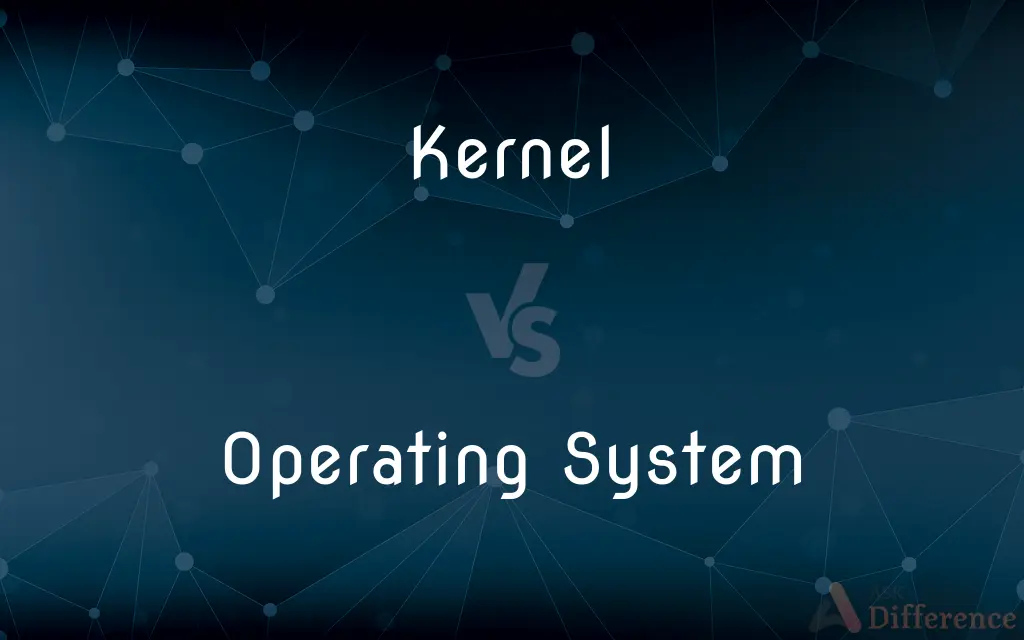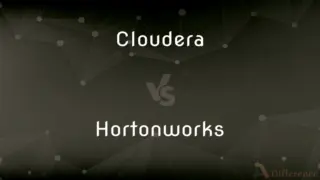Kernel vs. Operating System — What's the Difference?
By Tayyaba Rehman — Published on January 13, 2024
The Kernel is the core part of an Operating System (OS), managing hardware resources and enabling communication. The OS includes the Kernel, providing user interfaces, applications, and management tools for computer operations.

Difference Between Kernel and Operating System
Table of Contents
ADVERTISEMENT
Key Differences
The Kernel, a fundamental part of the OS, manages hardware resources, memory, and processes. It acts as a bridge between software and hardware, handling tasks like memory management and process scheduling.
The OS encompasses the Kernel and additional software components. It provides user interfaces, file management, and system utilities, enabling users to interact with the computer and run applications.
Directly interacting with the hardware, the Kernel handles critical tasks like managing memory, I/O operations, and process execution. It's responsible for ensuring system stability and resource allocation.
The OS includes a graphical user interface (GUI) or command-line interface (CLI), application software, and system utilities. It facilitates user interactions, file management, and application execution.
Acts as the core component, enabling software to communicate with hardware. It handles low-level functions, ensuring proper execution of system calls and managing hardware resources efficiently.
ADVERTISEMENT
The OS provides an environment for applications to run, manages file systems, permissions, and networking. It coordinates various system components for a seamless user experience.
Kernel lacks user interfaces or application-level functionalities, focusing on resource management and hardware interaction for system operation.
OS includes user-friendly interfaces, applications, and utilities making the system accessible and functional for users to perform tasks and run programs.
Comparison Chart
Scope
Core part managing hardware resources
Encompasses the Kernel, offers user interfaces, applications
Functions
Handles hardware interactions, memory management
Manages user interactions, applications, file systems
Components
Lacks user interfaces, focuses on resource management
Includes GUI, applications, system utilities
Interaction Level
Direct interaction with hardware
Provides user-friendly interfaces, application environments
Core Responsibility
Resource allocation, system stability
Offers an environment for user interaction and application running
Compare with Definitions
Kernel
Core part of an OS managing hardware resources and ensuring system stability.
The Kernel manages memory allocation and CPU utilization in an Operating System.
Operating System
Includes the Kernel, provides user interfaces and system management.
An Operating System offers a graphical interface for users to interact with the computer.
Kernel
Facilitates communication between software and hardware without user interfaces.
The Kernel interacts directly with hardware, executing system calls efficiently.
Operating System
Offers an environment for software execution and user interaction.
An Operating System provides an ecosystem for applications to run smoothly.
Kernel
Lacks user-facing functionalities, focuses on resource management.
The Kernel doesn't provide user interfaces but handles critical system operations.
Operating System
Manages hardware resources, applications, and user interactions.
The Operating System coordinates hardware resources and executes user applications.
Kernel
Ensures proper hardware resource allocation and process management.
The Kernel schedules processes, ensuring efficient use of CPU resources.
Operating System
Facilitates applications, file management, and system utilities.
The Operating System manages files, allowing users to organize data efficiently.
Kernel
Central part of the OS, responsible for low-level system operations.
The Kernel manages hardware devices and facilitates communication between software and hardware.
Operating System
Includes various utilities and tools for managing computer resources.
An Operating System offers system utilities for tasks like file management and maintenance.
Kernel
A grain or seed, as of a cereal grass, enclosed in a husk.
Kernel
The usually edible seed inside the hard covering of a nut or fruit stone.
Kernel
The central or most important part; the core
"The kernel of his practical religion was that it was respectable, and beneficial to one's business, to be seen going to services" (Sinclair Lewis).
Kernel
A small amount of something, especially when potentially developing into something else
Detected a kernel of anger in his remarks.
Kernel
The core, center, or essence of an object or system.
The kernel of an argument
Kernel
(botany) The central (usually edible) part of a nut, especially once the hard shell has been removed.
Kernel
(botany) A single seed or grain, especially of corn or wheat.
Kernel
The stone of certain fruits, such as peaches or plums.
Kernel
A small mass around which other matter is concreted; a nucleus; a concretion or hard lump in the flesh.
Kernel
(computing) The central part of many computer operating systems which manages the system's resources and the communication between hardware and software components.
The Linux kernel is open-source.
Kernel
(computing) The core engine of any complex software system.
Kernel
(calculus) A function used to define an integral transform.
The Dirichlet kernel convolved with a function yields its Fourier series approximation.
Kernel
(mathematics) A set of pairs of a mapping's domain which are mapped to the same value.
Kernel
For a given function (especially a linear map between vector spaces), the set of elements in the domain which are mapped to zero; (formally) given f : X → Y, the set {x ∈ X : f(x) = 0}.
If a function is continuous then its kernel is a closed set.
Kernel
For a category with zero morphisms: the equalizer of a given morphism and the zero morphism which is parallel to that given morphism.
Kernel
The set of members of a fuzzy set that are fully included (i.e., whose grade of membership is 1).
Kernel
(slang) The human clitoris.
Kernel
(chemistry) The nucleus and electrons of an atom excluding its valence electrons.
Kernel
To enclose within a kernel
Kernel
To crenellate
Kernel
The essential part of a seed; all that is within the seed walls; the edible substance contained in the shell of a nut; hence, anything included in a shell, husk, or integument; as, the kernel of a nut. See Illust. of Endocarp.
'A were as good crack a fusty nut with no kernel
Kernel
A single seed or grain; as, a kernel of corn.
Kernel
A small mass around which other matter is concreted; a nucleus; a concretion or hard lump in the flesh.
Kernel
The central, substantial or essential part of anything; the gist; the core; as, the kernel of an argument.
Kernel
To harden or ripen into kernels; to produce kernels.
Kernel
The inner and usually edible part of a seed or grain or nut or fruit stone;
Black walnut kernels are difficult to get out of the shell
Kernel
A single whole grain of a cereal;
A kernel of corn
Kernel
The choicest or most essential or most vital part of some idea or experience;
The gist of the prosecutor's argument
The heart and soul of the Republican Party
The nub of the story
Common Curiosities
What functionalities does an OS provide beyond the Kernel?
An OS includes user interfaces, applications, file management, and system utilities.
Is the Kernel part of the Operating System?
Yes, the Kernel is a core component within the Operating System, managing hardware resources.
What distinguishes an OS from the Kernel?
An OS includes the Kernel and additional software components like user interfaces and applications.
Is the Kernel responsible for file management in an OS?
No, the Kernel doesn't directly handle file management; it manages hardware and core system functions.
What does the Kernel manage in an OS?
The Kernel handles hardware resources, memory, process scheduling, and system calls.
Does the Kernel provide user interfaces?
No, the Kernel doesn't directly provide user interfaces but facilitates hardware interactions.
Can an OS function without a Kernel?
No, the Kernel is essential for an Operating System to manage hardware and core system operations.
How does the OS interact with hardware?
The OS interacts with hardware through the Kernel, which manages hardware resources.
Is the Kernel the first component to load when a computer starts?
Yes, the Kernel initializes first during the boot process, initializing hardware and essential services.
How does the OS benefit users beyond the Kernel?
The OS provides user-friendly interfaces, applications, and utilities for efficient computing.
Can the Kernel be updated independently of the Operating System?
Kernel updates often come bundled within Operating System updates and are closely tied to the OS version.
Can the Kernel run applications directly?
No, the Kernel doesn't run applications but facilitates their execution by managing hardware.
How does the Kernel manage memory resources in an OS?
The Kernel allocates, deallocates, and optimizes memory usage for processes and applications.
Does the OS manage peripherals like printers and keyboards?
Yes, the OS coordinates peripheral devices, ensuring their proper functioning.
What types of applications can an OS run?
An OS can run a wide array of applications, from productivity tools to multimedia software.
Share Your Discovery

Previous Comparison
Black Figs vs. Green Figs
Next Comparison
Cloudera vs. HortonworksAuthor Spotlight
Written by
Tayyaba RehmanTayyaba Rehman is a distinguished writer, currently serving as a primary contributor to askdifference.com. As a researcher in semantics and etymology, Tayyaba's passion for the complexity of languages and their distinctions has found a perfect home on the platform. Tayyaba delves into the intricacies of language, distinguishing between commonly confused words and phrases, thereby providing clarity for readers worldwide.













































